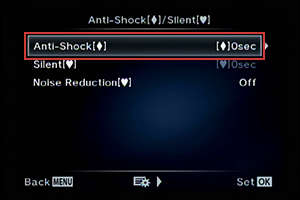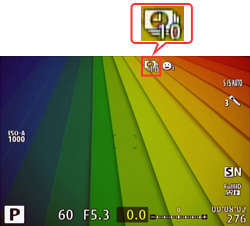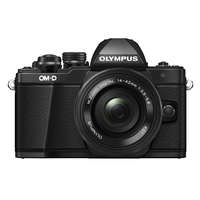
OM-D E-M10 Mark II Support Topics
Where can I see a list of frequently asked questions on my model?
Please click here for questions and answers for your EM-10 Mark II.
What comes packaged with the camera?
The following items are packaged with the camera:
- E-M10 MarkII camera body
- Lithium-ion Rechargeable Battery (BLS-50)
- Lithium-ion Battery Charger (BCS-5)
- Eyecup (EP-15)
- USB Cable (CB-USB6)
- Body Cap
- Shoulder Strap
- Software CD-ROM
- OLYMPUS Viewer 3 (Windows / Mac)
- Instruction Manual
- Warranty Card
What differentiates the E-M10 Mark II from the E-M10?
The following table describes the differences:

|

|
|
|---|---|---|
| Lens Mount | Micro Four Thirds Mount | |
| Image Processor | TruePic VII | |
| Effective Pixels | 16.05 million pixels | |
| Sensor Type | 4/3 High-speed Live MOS Sensor | |
| Image Stabilization | 5-axis stabilization, 4 steps, Corrects for angular shake, shift blur and rolling blur | 3-axis stabilization, 3.5 steps, Corrects for angular shake and rolling blur |
| Electronic Viewfinder (EVF) | 2.36 million dots Field of view: 100% Magnification: 1.23x (maximum) OVF simulation available |
1.44 million dots Field of view: 100% Magnification: 1.15x (maximum) |
| Monitor | Approx. 1,040,000 dots, Movable LCD (Upward tilting angle: 85 degrees, Downward tilting angle: 45 degrees) | Approx. 1,040,000 dots, Movable LCD (Upward tilting angle: 80 degrees, Downward tilting angle: 50 degrees) |
| Touch Panel | Available AF Targeting Pad equipped |
Available |
| Memory | SD Memory Card (SDHC, SDXC, UHS-II compatible, Eye-Fi card compatible) |
SD Memory Card (SDHC, SDXC, UHS-I compatible, Eye-Fi card compatible) |
| Flash | Built-in | |
| Hot Shoe | Available | |
| Front Dial Rear Dial |
Available | |
| Sequential Shooting (Sequential Shooting H mode, maximum) | Approx. 8.5 fps | Approx. 8.0 fps |
| Movie | MOV (MPEG-4AVC / H.264) AVI (Motion JPEG) |
|
| HD Movie Compatibility | Full HD (1920 x 1080) shooting possible | |
| AF System | High-speed imager AF (Contrast AF) | |
| AF Area | 81 points | |
| Focus Modes | Single AF (S-AF), Continuous AF (C-AF), Manual Focus (MF), S-AF+MF, AF tracking (C-AF+TR) | |
| Electronic Zoom Speed Setting | Available | Not available |
| ISO Sensitivity | Auto: ISO LOW (approx. 100) - 25600 (Customizable, Default: ISO LOW - 1600) Manual: LOW, ISO 200 - 25600 |
|
| Shutter Speed | 60 - 1 / 4000 sec. Bulb / Time shooting: 30 min. maximum (Default setting: 8 min.) |
|
| Silent Mode | Available | Not available |
| SCN (scene) Mode | 25 modes | 24 modes |
| Interval Shooting, Multiple Exposure | Multiple Exposure (2 frames max.), Live Bulb / Live Time shooting, Interval shooting / Time Lapse Movie (4K, Full HD, HD), Live Composite Photography, Photo in Movie | Multiple Exposure (2 frames max.), Live Bulb / Live Time shooting, Interval shooting / Time Lapse Movie (HD), Live Composite Photography, Photo in Movie |
| Art Filter | 14 art filters | 12 art filters |
| Photo Story | 5 modes | 4 modes |
| Creative Control | Highlight & Shadow, Multi Aspect, Enlarged display, ISO / White balance, Color Creator |
|
| Movie Effect | One Shot Echo Multi Echo Art Fade Old Film |
One Shot Echo Multi Echo Art Fade |
| Movie Tele-converter | 4x | |
| Keystone Compensation | Available | Not available |
| Level Gauge | 2-axis | |
| Built-in Wi-Fi | Available | |
| HDMI Output Connector (Type D) |
Available Live View Output via HDMI is possible |
Available |
| Menu Language | 34 languages, including Japanese and English | |
| Battery | BLS-50 (bundled) | BLS-5 (bundled) |
| Quick Sleep Mode | Available | Not available |
| Number of Storable Shots | Approx. 350 shots (When using the BLS-50 battery and Toshiba EXCERIA™ UHS-I SDHC card (Type1, 32GB), IS set to ON, based on CIPA test standards) Approx. 750 shots (When Quick Sleep Mode is On, based on CIPA test standards) |
Approx. 320 shots (When using the BLS-5 battery and Toshiba Super High Speed SDHC card (Class6, 4GB)) |
| Body | Metal exterior | |
| Weight |
|
|
| Dimensions (Excluding Protrusions) | 119.5 mm (W) x 83.1 mm (H) x 46.7 mm (D) / 4.7" (W) x 3.3" (H) x 1.8" (D) | 119.1 mm (W) x 82.3 mm (H) x 45.9 mm (D) / 4.7" (W) x 3.2" (H) x 1.8" (D) |
| Color | Silver, Black | Silver, Black (Limited Edition: Orange, Green, Black) |
| Camera Grip (sold separately) | ECG-3 | ECG-1 |
| Release Date | September 2015 | February 2014 |
What are the compression rates, and what size are the image files in each record mode?
[Still Pictures]
The following table shows the approximate values when shooting still pictures in the 4:3 aspect ratio.
| Record Mode | Number of Pixels | Compression Rate | File Format | Number of Storable Pictures 1GB SD / SDHC / SDXC card | File Size (Approx.) | |
|---|---|---|---|---|---|---|
| RAW | 4608 x 3456 | Lossless Compression | ORF | 55 | 17.3 MB | |
| L (Large) |
SF (SuperFine) |
1/2.7 | JPEG | 88 | 10.8 MB | |
| F (Fine) |
1/4 | 127 | 7.5 MB | |||
| N (Normal) |
1/8 | 274 | 3.5 MB | |||
| B (Basic) |
1/12 | 409 | 2.4 MB | |||
| M (Middle) |
SF | 3200 x 2400 | 1/2.7 | 172 | 5.6 MB | |
| F | 1/4 | 285 | 3.4 MB | |||
| N | 1/8 | 559 | 1.7 MB | |||
| B | 1/12 | 836 | 1.2 MB | |||
| SF | 2560 x 1920 | 1/2.7 | 300 | 3.2 MB | ||
| F | 1/4 | 442 | 2.2 MB | |||
| N | 1/8 | 859 | 1.1 MB | |||
| B | 1/12 | 1,271 | 0.8 MB | |||
| SF | 1920 x 1440 | 1/2.7 | 526 | 1.8 MB | ||
| F | 1/4 | 772 | 1.3 MB | |||
| N | 1/8 | 1,488 | 0.7 MB | |||
| B | 1/12 | 2,179 | 0.5 MB | |||
| SF | 1600 x 1200 | 1/2.7 | 753 | 1.3 MB | ||
| F | 1/4 | 1,089 | 0.9 MB | |||
| N | 1/8 | 2,104 | 0.5 MB | |||
| B | 1/12 | 2,906 | 0.4 MB | |||
| S (Small) |
SF | 1280 x 960 | 1/2.7 | 1,151 | 0.9 MB | |
| F | 1/4 | 1,649 | 0.6 MB | |||
| N | 1/8 | 3,051 | 0.4 MB | |||
| B | 1/12 | 4,359 | 0.3 MB | |||
| SF | 1024 x 768 | 1/2.7 | 1,743 | 0.6 MB | ||
| F | 1/4 | 2,441 | 0.4 MB | |||
| N | 1/8 | 4,359 | 0.3 MB | |||
| B | 1/12 | 6,102 | 0.2 MB | |||
| SF | 640 x 480 | 1/2.7 | 3,814 | 0.3 MB | ||
| F | 1/4 | 5,548 | 0.2 MB | |||
| N | 1/8 | 8,718 | 0.2 MB | |||
| B | 1/12 | 10,171 | 0.1 MB | |||
- The same image (Olympus' standard image) is used to calculate the photo capacity and file size in each mode.
- The capacity depends on the image quality, the type of memory card or whether print reservation is enabled. The number of remaining pictures on the LCD may not change even when a picture is taken or deleted.
- The capacity in this table differs from the number of remaining pictures displayed on the LCD. This table shows the approximate number, but the camera shows the maximum (up to 9999).
How do I set the Anti-Shock function?
What is Anti-Shock?
To prevent camera shake caused by the small vibrations that occur during shutter operation, Anti-Shock shooting is performed using an electronic front-curtain shutter.
When Anti-Shock is enabled, the shutter is released a while after the shutter button is pressed all the way down.
The interval between the shutter button is pressed and the shutter is released can be set from 0 second to 30 seconds. (Default setting is 0 second)
Please see the following procedure for how to enable Anti-Shock and how to set its interval:
How to enable Anti-Shock function
Select one of the items marked ![]() (Single shooting, sequential shooting, self-timer or custom self-timer) on the Super control panel or Live Control.
(Single shooting, sequential shooting, self-timer or custom self-timer) on the Super control panel or Live Control.

How to set the interval of Anti-Shock
The following procedure explains how to change the interval from the default 0 second to 1/4 seconds.
- Press the [MENU] button. In
 (Shooting Menu 2), select Anti-Shock[
(Shooting Menu 2), select Anti-Shock[
 ] / Silent [♥] and press the [OK] button.
] / Silent [♥] and press the [OK] button.

- Select Anti-Shock[
 ] and press the arrow pad Right button.
] and press the arrow pad Right button.

- Select [
 ]0sec and press the arrow pad Right button.
]0sec and press the arrow pad Right button.

- Select [
 ]1/4sec and press the [OK] button.
]1/4sec and press the [OK] button.

- Make sure the interval of Anti-Shock is changed.

How many pictures can be taken sequentially per second?
While the shutter button is fully depressed, you can shoot approximately 8.5 frames per second (max.).
| Mode | Image Quality | Sequential Shooting Speed | Recordable Pictures on Sequential Shooting |
|---|---|---|---|
| Sequential Shooting H | RAW | Approx. 8.5 frames per second (when image stabilization is OFF) | Approx. 22 frames *2 |
| Sequential Shooting L | Approx. 4.3 frames per second (when image stabilization is OFF) *1 | Up to card capacity *3 | |
| Sequential Shooting H | JPEG | Approx. 8.5 frames per second (when image stabilization is OFF) | Approx. 36 frames *2 |
| Sequential Shooting L | Approx. 4.3 frames per second (when image stabilization is OFF) *1 | Up to card capacity *3 |
- *1 In S-AF or MF mode (Approx. 4.0 frames per second in C-AF mode)
- *2 In sequential shooting H mode, 8.5 frames per second
- *3 In sequential shooting L mode, 4 frames per second
- * When using the M.ZUIKO DIGITAL ED 14-42mm F3.5-5.6 EZ lens
- * When using the Toshiba SDHC UHS-II R260·W240 EXCERIA™ PRO card
- * Based on Olympus testing
- Sequential shooting speed may differ according to the shooting condition; for example, the lens you use or its zoom position.
- When shooting in sequential shooting H mode, focus, exposure and white balance are locked at the first frame.
While shooting in this mode, the last picture taken is displayed briefly after the shutter button is pressed. - When shooting in sequential shooting L mode, focus and exposure is fixed based on the AF mode and AEL / AFL mode.
While shooting in this mode, the pictures taken are not displayed. You can playback the pictures after shooting. - When the battery check icon blinks because of low battery power, the camera stops the shooting and starts to store the pictures.
Depending on the amount of power remaining in the battery, the camera may not be able to store all pictures.
Does the flash automatically pop up when shooting in low light conditions?
No, the flash will not automatically pop up.
To use the flash unit, rotate the ON / OFF lever to ![]() UP.
UP.

How far can I adjust the angle of the LCD monitor?
The LCD monitor can be moved up and down.
You can tilt up the monitor to about 85-degree angle and tilt down to about 45-degree angle.

Can I attach the camera grip ECG-3 to other OM-D cameras?
The ECG-3 is a dedicated camera grip for E-M10 Mark II.
You cannot attach the camera grip to other Olympus OM-D series digital SLR cameras.
How many shots can be taken in time lapse photography and how long can I set its shooting interval?
Question :
How many shots can be taken in time lapse photography and how long can I set its shooting interval?
Answer:
You can shoot up to 999 shots in time lapse photography and you can set its shooting interval between 1 second and 24 hours.
The following procedure explains how to set and shoot time lapse photography.
How to set time lapse photography
Time lapse function is selectable when using the P, A, S or M shooting mode.
Press the [MENU] button. In Shooting Menu 1, select ![]() and press the [OK] button. In Intrvl. Sh./Time Lapse, select On and press the arrow pad Right button. Set the number of frames and interval to a desired value and press the [OK] button to complete the setting.
and press the [OK] button. In Intrvl. Sh./Time Lapse, select On and press the arrow pad Right button. Set the number of frames and interval to a desired value and press the [OK] button to complete the setting.

Number of Frames
Sets the number of frames of time lapse photography. You can choose between 1 and 999 shots.
Start Waiting Time
Sets the time from pressing the shutter button until the first picture is taken. You can choose between 1 second and 24 hours.
Interval Length
Sets the shooting interval after the shooting starts. You can choose between 1 second and 24 hours.
Time Lapse Movie
The sequence of time lapse photography can be converted to a movie.
Off: Records each frame as a still picture.
On: Records each frame as a still picture and generates a time lapse movie.
Movie Settings
You can choose the Movie Resolution (4K, Full HD, HD) and Frame Rate* (30fps, 15fps, 10fps, 5fps).
- * In 4K, the frame rate is fixed to 5fps.
- * In FullHD, you can choose the frame rate from 15fps, 10fps and 5fps.
How to take time lapse photography
When you set the time lapse photography to On, the icon for time lapse photography is displayed on the monitor. The number on the icon indicates the number of shots you can take.
Press the shutter button to start the time lapse photography.

- After autofocus, the camera starts shooting even if the image is not in focus. If you want to fix the focus position, shoot in MF mode.
- Rec View operates for 0.5 seconds.
- If the Start Waiting Time or Interval Length is set to 1 minutes 31 seconds or longer, the monitor and camera power turns off after 1 minute.
10 seconds before the setting time, the power automatically turns on again.
While the monitor is off, you can also turn the power on by pressing the shutter button. - When the time lapse shooting is finished, time lapse photography is set to Off.
- Time lapse photography is available only in P, A, S and M mode.
- When the AF mode is set to C-AF or C-AF+TR, the setting automatically changes to S-AF.
- Touch operation is disabled during time lapse photography.
- Time lapse photography cannot be used with HDR photography.
- Time lapse photography cannot be used simultaneously with Bulb, Time, Composite Shooting, Bracketing and Multiple Exposure.
- The flash will not work when the flash charging time is longer than the shooting interval.
- If the camera automatically turns off during time lapse photography, it turns on in time before the next shot.
- If any of the still pictures are not recorded correctly, the time lapse movie will not be generated.
- If there is not enough space on the card, time lapse movie is not recorded.
- Time lapse photography is cancelled if any of the following function is operated:
Mode dial, MENU button, button, lens release button or connecting the USB cable.
button, lens release button or connecting the USB cable. - Time lapse photography is cancelled if you turn off the camera.
- The shooting stops if there is not enough power left on the battery. Make sure your camera's battery is fully charged.
- Depending on the computer system, you may not be able to view 4K time lapse movies (.avi) on your computer.
- The compatible software for viewing 4K time lapse movie is OLYMPUS Viewer 3 (1.5 or later version).


